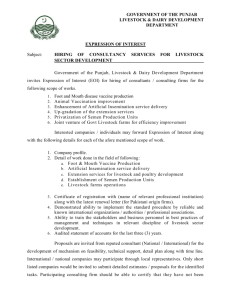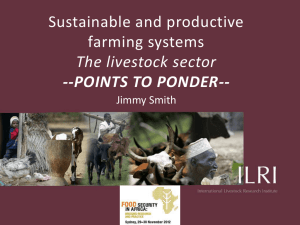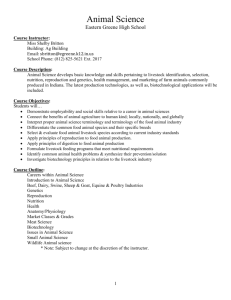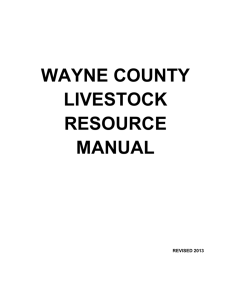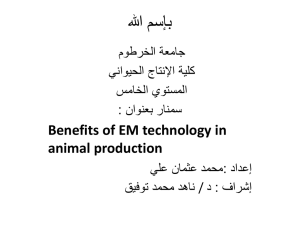OSP-Livestock-Dairy
advertisement
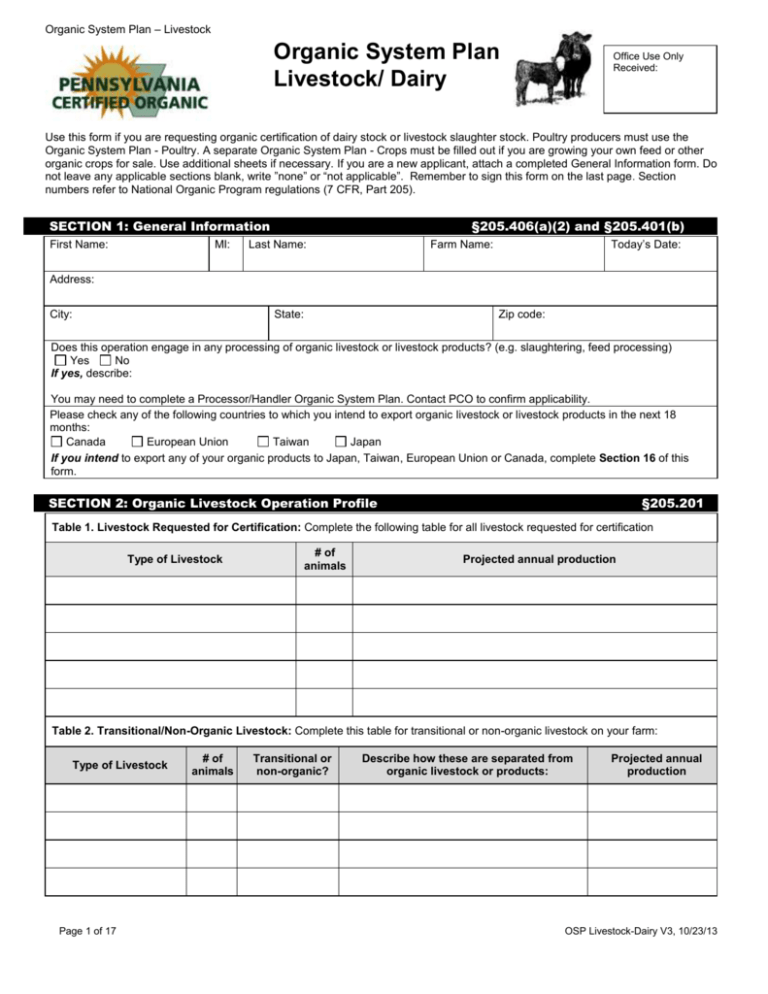
Organic System Plan – Livestock Organic System Plan Livestock/ Dairy Office Use Only Received: Use this form if you are requesting organic certification of dairy stock or livestock slaughter stock. Poultry producers must use the Organic System Plan - Poultry. A separate Organic System Plan - Crops must be filled out if you are growing your own feed or other organic crops for sale. Use additional sheets if necessary. If you are a new applicant, attach a completed General Information form. Do not leave any applicable sections blank, write ”none” or “not applicable”. Remember to sign this form on the last page . Section numbers refer to National Organic Program regulations (7 CFR, Part 205). SECTION 1: General Information First Name: MI: §205.406(a)(2) and §205.401(b) Last Name: Today’s Date: Farm Name: Address: City: State: Zip code: Does this operation engage in any processing of organic livestock or livestock products? (e.g. slaughtering, feed processing) Yes No If yes, describe: You may need to complete a Processor/Handler Organic System Plan. Contact PCO to confirm applicability. Please check any of the following countries to which you intend to export organic livestock or livestock products in the next 18 months: Canada European Union Taiwan Japan If you intend to export any of your organic products to Japan, Taiwan, European Union or Canada, complete Section 16 of this form. SECTION 2: Organic Livestock Operation Profile §205.201 Table 1. Livestock Requested for Certification: Complete the following table for all livestock requested for certification Type of Livestock # of animals Projected annual production Table 2. Transitional/Non-Organic Livestock: Complete this table for transitional or non-organic livestock on your farm: Type of Livestock Page 1 of 17 # of animals Transitional or non-organic? Describe how these are separated from organic livestock or products: Projected annual production OSP Livestock-Dairy V3, 10/23/13 Organic System Plan – Livestock 1. If not yet certified: a) Do you plan to transition a dairy herd? If Yes, date transition started: Yes No N/A b) Estimated milk ship date (if known): c) Provide milk company contact name and information: SECTION 3: Source of Animals §205.236 All organic livestock must be from certified organic sources unless breeding stock was purchased prior to the last third of the gestation period. Dairy herds are permitted a one-time whole herd conversion over a 12-month period - see §205.236(a)(2). 2. Do you raise all slaughter animals on farm (including organic cull animals)? Yes No Not Applicable 3. Do you raise replacement animals on farm? Yes No Not Applicable 4. Do you purchase any livestock? Yes No Table 3. Purchased Livestock: If yes, give specific information on livestock purchased within the past 12 months: Please write the type of livestock purchased, their identification no./name, date of purchase, projected real birthing date, the purchase source and what agency certified them. TYPE OF LIVESTOCK PURCHASED IDENTIFICATION NO./ NAME DATE OF PURCHASE PROJECTED OR REAL BIRTHING DATE PURCHASE SOURCE SECTION 4: Livestock Feed and Feed Supplements CERTIFIED BY WHAT AGENCY? §205.237 For dairy livestock in transition, all feed must be either third year transitional material from your own farm or 100% organic. Dairy livestock in transition must comply with the Pasture Rule requirements during the one year transition, including receiving at least 30% dry matter intake from pasture over the grazing season, minimum of 120 days. Also, you must document the amount of each type of feed actually fed to each type and class of animal. You may use PCO’s Feed Ration/ DMI Calculation Worksheet. 5. Describe your grazing season, including dates/total number of days: 6. How will you calculate dry matter intake for each type/class of ruminant livestock? Using the tables and worksheets provided by PCO Using other calculation method (explain) and published reference material (list source): 7. Describe the classes or groups of animals you manage (i.e. lactating cows, bred heifers, unbred heifers, dry cows). Include the breed and average weight for each class/group: Feed Ration(s) Attached Page 2 of 17 OSP Livestock-Dairy V3, 10/23/13 Organic System Plan – Livestock Table 4: Proposed Feed Ration. Provide a description of the total feed ration for each class of ruminant livestock you manage. This should include all feed produced on-farm and purchased from off-farm sources. You may provide the information in your own format as an attachment. No ruminant animals # of Days Ration Dry Matter Type / Class Ration Period Demand (DMD) EXAMPLE: Early Spring 15 Days 28 lbs. 6 lbs Org. Corn Silage, 10 lbs Org. Dry Hay, 4 Lactating Jersey lbs Org. Baleage Cows Page 3 of 17 OSP Livestock-Dairy V3, 10/23/13 Organic System Plan – Livestock Table 5. Dry Matter Value of Feed: List the dry matter value for each type of feed listed in Table 4. If no values are reported, PCO will use an average dry matter book value to evaluate your feed ration. No ruminant animals Type of Feed Dry Matter Value of Feed Example: Corn Silage Example: 40% Page 4 of 17 OSP Livestock-Dairy V3, 10/23/13 Organic System Plan – Livestock 8. Do you process feed (mix, grind, roast, extrude, etc.) on-farm? If Yes, is the equipment also used to process conventional products? If Yes, how is equipment cleaned prior to processing organic feed to prevent contamination? Yes No Yes No 9. What is your plan for emergency feed supplies? a) Grazing season emergency feed and pasture plan: b) Non-grazing season emergency feed plan: 10. Do you provide feed supplements and additives in amounts greater than those needed for adequate nutrition (i.e. above labeled rates of consumption)? Yes No If Yes, list all feed supplements and additives, silage inoculants, preservatives, etc. on the enclosed Livestock Materials/ Medicine Cabinet Inventory form. All feed supplements and additives must be reviewed and approved PRIOR to using. Table 6. Feed Storage: Describe your feed storage locations in the table below: Type of Storage Storage ID# Type of feed stored Capacity Organic (O), Conventional (C), Buffer (B) SECTION 5: Water Water used for organic livestock must be potable and readily accessible. Water tests for coliform bacteria, nitrates and/or known contaminants may be required. 11. How do you provide clean water to your livestock? On-site well Municipal River/Creek/Pond Spring Other (specify): 12. How do you monitor water quality? Water testing Visually By taste By smell Other (specify): 13. Do you test your water? Yes No If Yes, what was the date of the last test? (Have results ready to show inspector) 14. Were results of this test satisfactory? Yes No If No, please explain: 15. If you use additives in the water, list them and state reason for use: No additives used *Be sure to add all water additives to your Livestock Materials/ Medicine Cabinet Inventory form. 16. If livestock have access to a river, creek, or pond, how do you prevent bank erosion? No access Page 5 of 17 OSP Livestock-Dairy V3, 10/23/13 Organic System Plan – Livestock SECTION 6: Housing §205.239 Livestock living conditions must provide reasonable freedom of movement, lack of crowding, proper sanitation, fresh air, sunshine, appropriate shelter and adequate bedding. Pasture is required for ruminants. 17. What type of housing do you use? 18. Do you have an exercise yard or feeding pad for outdoor access during the non-grazing season? If yes, describe: Yes No a) Number and type of animals per area: b) Square Footage of area: 19. Describe the space provided for each type of livestock: Animal Type Indoor Space (head / sq ft.) Outdoor Pens & Runs (head / sq. ft.) 20. Describe the type of bedding used: 21. Is bedding certified organic? Yes No Not Applicable *Keep organic certificates for bedding on file for the inspector to review. 22. How often and with what is housing cleaned out? *List sanitation or cleaning products used on Livestock Materials/ Medicine Cabinet Inventory form. 23. Do all ruminant animals have access to pasture, including calves over 6 months old? If No, explain: Yes No 24. If you will temporarily deny livestock access to pasture during the grazing season, describe the reasons and duration: (example: 4:30-5:30 daily, cows in for milking) Page 6 of 17 OSP Livestock-Dairy V3, 10/23/13 Organic System Plan – Livestock 25. If you will temporarily confine livestock during the non grazing season, describe reasons and duration: (Example: temperatures unsafe (December and January)) 26. How long are animals indoors (hours per day)? Spring Summer Fall Winter 27. If any wood treated with prohibited products is used, does it come into contact with livestock? If Yes, please describe and include date of installation or replacement and location: Yes No None Used 28. Do you board livestock elsewhere? Yes No *If Yes, you must fill out an off Farm Boarding Supplement prior to moving livestock. Contact PCO to request the form. SECTION 7: Health Management §205.238 A proactive health management program is required to prevent health problems and potential use of prohibited materials. If prohibited treatments are used, the treated animals and/or their products must not be sold as organic. Records must be kept of all treatments, whether they are allowed or not, and whether administered by you or a veterinarian. GENERAL INFORMATION: 29. Identify the general components of your animal health management program: Selective breeding Vaccinations Raise own replacement stock Good sanitation Good quality feed Isolation for purchased/diseased animals Access to outdoors Pasture rotation Dry bedding Nutritional supplements Culling Good ventilation in housing Probiotics Homeopathy Other (specify): 30. Describe how you monitor the effectiveness of your health care management: 31. How often do you conduct health care monitoring? Daily Weekly Annually As needed Other (specify): Include ALL HEALTHCARE TREATMENTS on the Livestock Materials/ Medicine Cabinet Inventory form, including any emergency treatments, prohibited treatments, parasiticides, vaccinations, etc. used by you or a veterinarian failure to do so could jeopardize your certification.* 32. Name and phone number of your veterinarian: 33. Are any of the livestock and or their products been subject to the use of systemic pain killers or analgesics such as Lidocaine or Procaine? (Taiwan Export) Yes No If yes, please identify which animals have been treated: B) PARASITE CONTROL: 34. Describe how you prevent or control internal and external parasites on your operation: Not a problem *List all materials on your Livestock Materials/ Medicine Cabinet Inventory form. Page 7 of 17 OSP Livestock-Dairy V3, 10/23/13 Organic System Plan – Livestock C) FLY CONTROL: Not a problem 35. If flies are a problem in your operation, what do you do to prevent or control them? *List all materials on your Livestock Materials/ Medicine Cabinet Inventory form. D) PREDATOR CONTROL: 36. Check which predators you have problems with: Hawks Feral cats Raccoons/skunks Dogs Foxes Coyotes Not a problem Other (specify): 37. Describe how you handle predator problems in this table: Predator Problem Controls Used Products Used* E) SURGICAL PRACTICES: §205.238(a)(5) of the USDA regulations permits performance of physical alterations as needed to promote the animals’ welfare and in a manner that minimizes pain and stress. 38. Describe surgical practices you use, such as dehorning, castration, tail, docking and types of livestock, age of livestock, reasons for use and procedures used to minimize pain and stress: Not used *List all materials on your Livestock Materials/ Medicine Cabinet Inventory form. SECTION 8: Manure & Pasture Management §205.239 & §205.240 A. MANURE MANAGEMENT A producer of an organic livestock operation must manage manure in a manner that does not contribute to contamination of crops, soil or water by plant nutrients, heavy metals, or pathogenic organisms and optimizes recycling of nutrients. 39. What forms of manure do you use: Liquid Semi-solid/piled Fully composted Not used 40. If manure from your livestock is used on your fields, describe how it is used: 41. List ingredients/additives (example: bedding, barn lime, inoculants, preservatives): 42. During what months do you apply manure/compost? 43. Acres of land available for manure application: 44. Estimated quantity of manure generated per year: tons 45. Describe how you monitor the effectiveness of your manure management: 46. How often do you conduct manure management monitoring? Weekly Page 8 of 17 Monthly Annually As needed Other (specify): OSP Livestock-Dairy V3, 10/23/13 Organic System Plan – Livestock B. PASTURE MANAGEMENT A Pasture Management Plan must include the following: type of grazing methods and other management practices that ensure sufficient quality and quantity of pasture is available for all ruminants to graze throughout the grazing season; soil fertility, seeding systems, and erosion control of pasture; types of pasture; and a map identifying land used as pasture, the location and types of fences, and sources of shade and water sources. No ruminant animals, skip to Section 9 47. Do you have an existing pasture management plan developed in cooperation with a federal, state or local conservation office? Yes No If Yes, attach plan If No, complete the following questions. Attach a separate sheet if needed. Plan attached a) Describe your grazing methods: b) Describe your pasture soil fertility, seeding, and erosion control system: c) Describe the types of pastures you manage (i.e. clover, mixed grasses, alfalfa, sorghum sudan): d) What types of fencing do you use? Permanent Temporary 48. Do you sell your animals as organic slaughter stock? If No, skip to the next section. Yes No Yes No 49. What age are the animals at the time of slaughter? 50. What is the length of your finishing period? 51. Will your animals be fed in a feedlot during finishing? 52. Describe the feed ration of the slaughter stock during the finishing period: *Your farm map must identify all pastures, location/type of permanent fences, shade, and water sources. (Please attach on separate sheet of paper) SECTION 9: Milk Handling Milk handling procedures must meet regulatory requirements for sanitation. 53. What type of milk handling system do you use: Pipeline Automated Step saver We are NOT a dairy operation Hand milking Parlor Tie stalls Stanchions Other (specify): 54. How are you licensed? Grade A 55. Do you have a raw milk permit? Page 9 of 17 Grade B Yes Other (specify): No OSP Livestock-Dairy V3, 10/23/13 Organic System Plan – Livestock 56. Do you: Pasteurize Bottle milk If you pasteurize or bottle milk you must complete a Processor Handler Organic System Plan. 57. Describe cleaning cycle for milking equipment (water temperature, number of rinses, etc.): 58. Do you do a final water rinse? If No, explain why not: Yes No *List detergent, acid cleaner and sanitizer used, and products used to clean animals, such as teat dips and udder washes on enclosed Livestock Materials/ Medicine Cabinet Inventory form. 59. How is wastewater from cleaning and sanitizing of milking equipment disposed of? Municipal sewage Manure pit/lagoon On-farm septic Field drain Other (specify): 60. How many animals do you currently milk? 61. How often do you change inflations? Not used Report production for the last six milkings in the table below: Date Pounds produced Date Pounds produced Date 1. 3. 5. 2. 4. 6. Pounds produced SECTION 10: Livestock Transportation If livestock are transported for any reason, complete this section. If not, proceed to Section 11. 62. Are livestock transported? If No, proceed to the next section. If Yes, What form of transportation is used and when are livestock transported? Yes No Yes No 66. Are animals provided with food in transit? If Yes, is feed certified organic? Yes No I don’t know, I am not responsible for providing feed during transit Yes No 67. Are animals provided with water in transit? If Yes, are any substances added to the water? Yes No I don’t know, I am not responsible for providing water during transit Yes No 63. How are animals loaded? 64. Do you use electric prods? 65. How long does transportation take? SECTION 11: Handling for Slaughter §205.27 0 Meat to be sold or labeled as organic must be slaughtered at a certified organic facility. If you slaughter your livestock on farm, or at a certified organic facility and supply the label for this meat, an Organic System Plan Processor/ Handler is required. Contact PCO to request the form. Page 10 of 17 OSP Livestock-Dairy V3, 10/23/13 Organic System Plan – Livestock 68. Are you selling meat products as organic? If No, proceed to the next section. Yes No 69. Describe who slaughters your animals (i.e. slaughter on-farm by you or off-farm at a slaughter facility): 70. If slaughtered off-farm, provide the name, address, and phone number of facility where your animals are slaughtered: 71. Is the facility certified organic? If Yes, by what agency? Yes No 72. Where are animals kept after delivery to slaughter facility, but before slaughter? 73. Are organic animals housed separately from non-organic animals? Yes No 74. How are organic meat products stored? 75. Where are organic meat products sold? 76. Who is identified as the final handler on the label (i.e. your farm name or the certified organic slaughter facility)? 77. Who is identified as the certifier on the label (i.e. PCO)? SECTION 12: Facility Pest Management §205.271 Complete this section to describe pest control practices and materials used in any facility where organic livestock or livestock products are produced, and/or stored, including but not limited to feed storage areas, inside milk house, inside barn, or outside barn (if animals have potential access). 78. Does this operation use any facilities, such as those stated above, in the production or storage of organic livestock or livestock products and have pest problems in those facilities? Yes No If No, skip to the next section. 79. Describe the facilities and the livestock products produced or stored in those facilities: 80. What type of facility pest management system(s) do you use? In-house: name of responsible person: Contracted pest control service (name, phone no.): 81. Check all facility pest problems you encounter: Flying insects Crawling insects Spiders Birds Page 11 of 17 Rats Mice Other(specify): OSP Livestock-Dairy V3, 10/23/13 Organic System Plan – Livestock 82. Check all pest management practices you use. Note: All materials used for facility pest management must be listed on your Materials Used Form. Good sanitation Release of beneficials Removal of exterior habitat/food sources Sticky traps Cleanup of spilled product Pheromone traps Mowing Mechanical traps Physical barriers Non-synthetic substances consistent with the National List Monitoring devices (e.g. pyrethrum) Repair of holes, cracks, etc. Synthetic substance consistent with the National List (e.g. Screened windows, vents, etc. vitamin D3 bait) Inspection zones around interior perimeter Synthetic substance NOT on the National List (e.g. most Electrocutors commercially available rodent bait)* Ultrasound/light devices Other (specify): *If you want to use a synthetic not on the National List you must receive authorization from PCO prior to use. 83. Describe monitoring, including frequency, used to determine effectiveness of management practices above: 84. If pest control materials are used, where are they stored? 85. What records do you maintain to document pesticide use and measures taken to prevent contamination of organic products? *Attach facility map showing location of pest traps and monitoring devices. Map Attached SECTION 13: Animal Identification §205.236 Records sufficient to preserve the identity of all organically managed animals must be kept. 86. Describe your animal identification system: 87. If animals were to be treated with prohibited or restricted materials, how would you plan to identify and/or segregate those animals? SECTION 14: Record Keeping §205.236 USDA regulations require documentation of purchased animals and/or breeding records; purchased feed and feed supplements; health records; and sales/shipping records. Have your records available for review by the inspector. Check types of records you keep: Feed (including amounts and type of feed actually fed to each type and class of animal and seasonal feed rations changes) Documentation of purchased animals Purchased feed/feed supplements Access to pasture Organic certificates for purchased feed/ organic bedding Somatic cell/plate count Milk production Sales Feed storage Breeding Feed labels Shipping/transportation Health Slaughter Other (specify): SECTION 15: Marketing TYPE OF MARKETING: Farmers market Wholesale to processor Page 12 of 17 §205.303 Direct to retail Contract to buyer CSA/subscription service Other (specify): On-farm retail Wholesale OSP Livestock-Dairy V3, 10/23/13 Organic System Plan – Livestock 88. Do you use or plan to use any labels and/or marketing materials? If No, proceed to the next section. If yes, include a copy of the labels/marketing materials. Yes No 89. Do your labels identify Pennsylvania Certified Organic as the certifying agent? Yes No 90. Do you use or plan to use the PCO logo on the label or marketing materials? Yes No 91. Do you intend to use the USDA logo on the label or marketing materials? Yes No SECTION 16: International Export: Canada, Taiwan, European Union, Japan Please provide the following information even if you do not currently intend to export any organic products to Canada, European Union, Taiwan, or Japan in order for PCO to review this information. This will expedite any export verification needs you or your customers may have in the future. However, this information is not required for your Organic System Plan to be considered complete. A. CANADA N/A 92. If exporting swine or swine products, provide the stocking densities for these animals: Indoor Space (head / sq ft) Outdoor Pens & Runs (head / sq ft) 93. Are you using any labels for exported products other than labels already approved by PCO? If yes, attach labels for PCO to review. Yes No *Note: The 100% Organic Label is not permitted in Canada. Labels must be bilingual (English and French). Livestock Requested for Export to Canada Number of Animals Livestock Products Requested for Export to Canada Product Amount Estimated for Export B. EUROPEAN UNION N/A 94. Are you using any labels for products exported to the European Union other than labels already approved by PCO? *Note: The 100% Organic Label is not permitted in the European Union. Yes No If yes, attach labels for PCO to review. Livestock Requested for Export to European Union C. TAIWAN Number of Animals Livestock Products Requested for Export to European Union Product Amount Estimated for Export N/A 95. If livestock products are to be exported to Taiwan, were systemic painkillers or analgesics, including lidocaine or procaine used in the animals’ management? Yes No If yes, list. Page 13 of 17 OSP Livestock-Dairy V3, 10/23/13 Organic System Plan – Livestock Livestock Requested for Export to Taiwan Number of Animals Livestock Products Requested for Export to Taiwan Product Amount Estimated for Export D. JAPAN N/A 96. Do you use livestock inputs that contain: a. Alkali-extracted humic acid? b. Lignin sulfonate (used as a flotation agent)? Livestock Requested for Export to Japan Number of Animals Yes Yes Livestock Products Requested for Export to Japan No No Product Amount Estimated for Export SECTION 17: “PCO 100% Grassfed” Certification ☐ We are not requesting “ PCO 100% Grassfed” certification. 97. List the livestock and/or livestock products requested for “ PCO 100% Grassfed” certification: 98. Will your operation be: ☐ All “PCO 100% Grassfed” certified animals ☐ Some “ PCO 100% Grassfed” certified animals and some animals not certified as “PCO 100% Grassfed” (split operation) If managing a split operation, how do you identify certified and non-certified “PCO 100% Grassfed” livestock? 99. Do you plan to transition a “PCO 100% Grassfed” herd? If yes, date transition started: YES NO If no, did you purchase a certified grassfed herd? YES NO YES NO If yes, what is the source and who are they certified by? 100. Do you raise replacement animals on farm for “PCO 100% Grassfed” certification? 101. Do you purchase any replacement animals that are certified grassfed? YES NO If yes, give specific information on livestock purchased within the past 12 months: Please write the type of livestock purchased, their identification no./name, date of purchase, projected real birthing date, the purchase source and what agency certified them. Type of Livestock Page 14 of 17 Identification Date of Purchase Projected or Real Purchase Source Certifed OSP Livestock-Dairy V3, 10/23/13 Organic System Plan – Livestock No./Name Birthing Date Grassfed by What Agency? 102. Describe feed ration (if different than ration listed in Table 4): Same ration as described in Table 4 103. Do you feed: Milk (after weaning) Grain and grain-by-products Corn kernels or corn kernel by-products Cake or meal feedstuffs Concentrates Food processing by-products or waste Small grain or corn allowed to mature past the vegetative (pre-grain/pre-boot) state 104. Do you feed sprouted grains with the root portion attached? YES NO N/A 105. How do you ensure that pastures that pastures that contain grain or corn crops are not intentionally managed to allow grain or corn crops to mature past the vegetative (pre-grain/pre-boot) state? YES NO N/A 106. Do you board “PCO 100% Grassfed” certified livestock elsewhere? YES NO If yes, you must complete an Off-Farm Boarding Supplement form prior to moving livestock. Contact PCO to request form. 107. Do you label any products as “PCO 100% Grassfed”? YES NO If yes, you must complete a Processor/Handler Organic System Plan and Organic Product Profile for each product. 108. Does your organic recordkeeping system address the additional requirements of the “PCO 100% Grassfed” standard? YES If not, what additional records are kept to ensure compliance with the “PCO 100% Grassfed” standards? NO 109. Additional Comments: SECTION 18: Conflict of Interest §205.501 110. Have you used any organic production consultants for your operation in the last 12 months? Yes No (This does not refer to your inspector, certification specialist, or other PCO representative involved with your certification review.) If yes, list the name and contact information for organic production consultant(s) your operation has used in last 12 months (7 CFR §205.501(a)(11)(ii)): SECTION 19: Previous Organic Certification §205.401 111. List current organic certification by other agencies and dates: If currently certified by another agency, submit a copy of your current certificate and verification of the items you are certified to produce/sell. Page 15 of 17 OSP Livestock-Dairy V3, 10/23/13 Organic System Plan – Livestock 112. If currently certified organic, has your operation received a non-compliance(s) or been issued a proposed suspension or proposed revocation that has not yet been resolved? Yes No If yes, submit a copy of any adverse action notice including: notification of noncompliance, notification of proposed suspension or proposed revocation issued to you and a description of any actions taken by you to correct the non-compliance(s) noted in the adverse action notice, including evidence of such corrections an resolution letter from certifier, if any. 113. If previously certified, list names of agencies, dates, non-compliances and reasons for surrender or termination of certification: 114. Have you ever been denied organic certification or has your organic certification ever been withdrawn, surrendered suspended or revoked? Yes No If yes, submit a copy of any adverse action notice, including suspension, revocation or denial of certification issued to you and a description of any actions taken by you to correct the non-compliances noted in the notification, including evidence of such corrections and resolution letter from certifier or the National Organic Program Administrator, if any. If certification was withdrawn or surrendered, provide reason: 115. Gross organic sales of organic crops in previous calendar year: $ If none sold, enter 0. SECTION 20: Affirmation Information provided on this application is held in strict confidence and will be used only for certification purposes. I affirm that all statements made in this application are true and correct. To the best of my knowledge, no prohibited materials have been applied to any of my organically managed fields during the three-year period prior to projected harvest. I understand and agree as follows: 1. My operation may be subject to unannounced inspection and/or sampling for residues at any time as deemed appropriate to ensure compliance with the National Organic Program. 2. Acceptance of this questionnaire in no way implies granting of certification by the certifying agent. 3. Failure to comply with the applicable regulations, policies or procedures, or giving false information may result in denial, suspension, revocation or termination of certification. 4. Payment of all certification fees is a condition of certification. As required by the National Organic Program, and as conditions of certification I agree to: 1. Cooperate with the certification process by completing all documentation requested. 2. Make every effort to ensure that no prohibited products have been used, applied or otherwise allowed to compromise the integrity of the organic crops or products produced or sold by me. 3. Provide access to all areas and parts of my operation, including records, products and personnel. 4. Comply with the National Organic Program Rule (7 CFR Part 205) and Pennsylvania Certified Organic certification policies and procedures. 5. Make appropriate certification claims, which accurately reflect the type of certification granted 6. Ensure that my certificate or certification report is not used in a misleading manner and does not harm PCO. 7. Only use certification claims, or the PCO name and logo, to indicate that products are in compliance with PCO standards, and use them correctly on advertising, marketing and packaging materials. 8. Discontinue use of certification claims, and PCO name and logo, upon surrender, suspension, revocation or termination of certification, and return any certification documents or materials required by PCO. 9. Notify PCO of any significant changes to my operation’s organic system plan. 10. Notify PCO concerning any application, including drift, of a prohibited substance to any field, production unit, site, facility, livestock, or product that is part of an operation. 11. Comply with all conditions of certification listed on Certification Reports or other certification documents. I understand that failure to abide by the above requirements may result in denial, suspension or revocation of my organic certification, prosecution for fraud or misrepresentation, denial of services, or any other remedy allowed by law. I give permission for PCO to release information from my file to other recognized certification organizations for purposes of document review. I understand that PCO will obtain a confidentiality statement from the requesting certifier before releasing any information. PCO has my permission to obtain information, documents, or materials related to certification or de-certification from other certifiers. Your signature(s): Page 16 of 17 Date: OSP Livestock-Dairy V3, 10/23/13 Organic System Plan – Livestock If applicable: Signature of Contracted Grower: Date: Required attachments: These records must be returned with your application or it may be returned to you resulting in a delay of the certification process. General Information Form (if new applicant) Maps of the operation (including field #’s, acreage, buildings and adjoining land use) Field and Pasture Records (with prior land use statements if not managed by you for the past three years) Livestock Materials – Medicine Cabinet Inventory Labels used on your organic product(s) (if applicable) Brochures and/or other marketing materials (if applicable) Page 17 of 17 OSP Livestock-Dairy V3, 10/23/13


